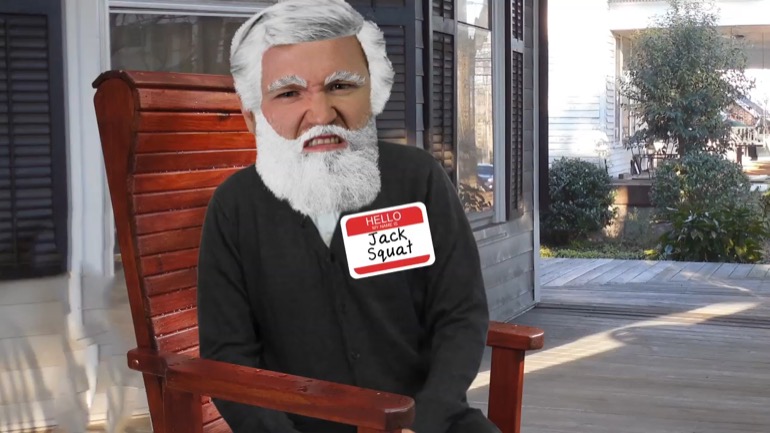ShmoopTube
Where Monty Python meets your 10th grade teacher.
Search Thousands of Shmoop Videos
Principles of Finance Videos 166 videos
How is a company... born? Can it be performed via C-section? Is there a midwife present? Do its parents get in a fight over what to name it? In thi...
Company Formation, Structure, and Inception: Unit Intro. Sorry, Leo DiCaprio fans—we're not going to be breaking down the plot of Inception. We'r...
Okay, so you want to be a company financial manager. It's basically up to you to make money for the shareholders. It would also be swell if you mad...
Principles of Finance: Unit 4, Liquidity and Cash Stash 9 Views
Share It!
Description:
What are liquidity and cash stash? Well, they have to do with having quick, easy cash on hand.
Transcript
- 00:00
Principles of finance a la shmoop liquidity and cash stash as we all know [Briefcase of liquidity and cash]
- 00:08
liquidity rules the world and well it does so not even in a cool water world
- 00:13
sorta way ok so much attention to this notion of liquidity which until you
- 00:18
started this video you might have thought was about whether or not your [Person opens can of cola]
- 00:22
diet coke needed refilling well why does liquidity matter so much
Full Transcript
- 00:26
well because without it you can't pay your employees, your rent, your heating
- 00:30
bill, liquidity is just handy cash such that if you have a lot of it well then
- 00:35
your company can handle not only its normal monthly bills but also prolonged
- 00:39
periods of a harsh economic or industry environment it can also handle your [Samsung galaxy note on fire]
- 00:45
company stumbling through a bad product launch, a lawsuit and you know any other
- 00:50
curveballs that come your way so said another way if you have a lot of
- 00:54
liquidity you have an easy time accessing your own cash or converting
- 00:58
your inventory or assets into cash quickly and you have a high ratio of
- 01:03
easy cash to costs so step back and think logically about what a [Man giving presentation of mathematical model of liquidity]
- 01:08
mathematical equation in liquidity might involve well your company has a thousand
- 01:12
employees, employees have an average salary of 70 grand a year
- 01:16
so with benefits you provide as a company it costs you about a hundred
- 01:20
grand a year to employ that $70,000 a year take-home employee do the
- 01:24
multiplication and you have a hundred million dollars of ongoing employee [Formula of employee costs]
- 01:28
costs you check through your other main expenses, rents 10 million a year
- 01:32
computers, food, coffee, travel and everything else about 20 million those
- 01:35
are the fixed recurring costs right well you have to pay them each year whether
- 01:39
you'll want to or not unless you decide to a drive your company's lower but when [Man driving car and falls asleep]
- 01:44
you calculate liquidity ratios you don't presume diminution of production meaning
- 01:50
you're going at full capacity just like you always were..You then look at the
- 01:54
variable costs what does all this mean well you spend 50 million dollars a year [Variable cost examples]
- 01:58
on marketing could you cut back on marketing sure but then sales would
- 02:03
probably get hit a year or two or three later without a new plastic stamping
- 02:08
plant Barbie will have no iPhone 22 and well you'll sell a lot fewer of her [Girl holding a barbie doll]
- 02:13
eventually.. so you really hate to cut back especially when your competitors
- 02:17
will seize that opportunity to you know poke you in the eye or they'll poke you [Girl pokes man in the eye]
- 02:24
somewhere worse... well let's pretend we're a mutual fund company we
- 02:26
don't make anything other than good decisions and these are all of our
- 02:31
expenses to operate the company that's 100 million dollars in employee costs 10
- 02:35
million in rent 20 million in coffee we love our coffee and 50 million bucks [Company expenses list]
- 02:39
in marketing all right the total expenses are 180 million so how do you
- 02:43
conceptually define liquid here like if you had on your balance sheet net of 180
- 02:48
million dollars just sitting there untouched unless Armageddon hit, would [Asteroid strikes Earth]
- 02:53
you feel liquid well yeah probably at least in most industries but what about
- 02:56
our mutual fund company well in that world you live and die based on the
- 03:00
health or lack thereof in the stock market and markets can get really ugly
- 03:04
for very long periods of time very fast and as you probably remember the 1970s [Dow Jones industrial average stock graph]
- 03:10
saw very little market appreciation and that was for a whole decade well even in
- 03:15
a bad market a mutual fund company collects its fees but if the market is
- 03:19
low they collect fewer fees so for a conservative mutual fund company how
- 03:24
many years of expenses well do they need to have assuming zero revenues to feel
- 03:29
liquid one year, two year, three years.. you know well probably somewhere in there is
- 03:33
the right answer it's you gotta have a lot for Armageddon because well you fear [Explosion occurs in the distance of a wasteland]
- 03:37
the nuke in which case well if we really did get nuked we'd have myriad of other
- 03:41
things to worry about beyond cash liquidity let's put some mathematical
- 03:44
meat on the bones and map out a means for viewing liquidity and don't get [Man chopping meat]
- 03:49
caught up in $5 words and fancy weird accounting terms when you think about
- 03:53
basic concepts like can I pay my freakin bills.. that concept is easy you pay your
- 03:58
rent or you live in your Prius the first pit stop on the liquidity track is the [Man sleeping in a Prius]
- 04:03
current ratio... current means within the next year or less it's
- 04:08
a balance sheet term and we covered it in an earlier video and recall that
- 04:12
current assets mean basically cash, marketable securities like shares of
- 04:17
goog, government bonds, ounces of gold, accounts receivable presumably people
- 04:22
will pay you within the next year note that a lot of companies carry
- 04:26
accounts receivable as a net number meaning that they net out the doubtful
- 04:31
accounts the deadbeats ie those likely to not pay because of the middle finger [Girl working and giving the middle finger]
- 04:35
thing or because they went bankrupt usually there is some history behind
- 04:39
this number like well in the last five years the company averaged 5% bad
- 04:43
accounts so if they're actually owed 100 million dollars the company would show
- 04:47
accounts receivable as 95 million having netted out the likely deadbeats
- 04:52
Another key metric you'll need to know about is accounts receivable
- 04:56
turnover that is you sell something to a customer who has to pay you in 90 days [Customer and employer trading cash]
- 05:01
well it's great that you made that sale but that sale cost you liquidity and
- 05:06
that you had to use your cash for inventory assembly shipping contracts
- 05:10
and so on. So at the moment of sale the sale sucked up liquidity and you can [Sale sucked up by vacuum]
- 05:16
imagine if you were net 365 days to pay you instead of 90 days to pay you
- 05:21
you could get very illiquid very fast so metering and measuring how quickly your
- 05:26
accounts receivable pay you is a really big idea the ratio is calculated as [Accounts turnover ratio example]
- 05:32
annual credit sales over accounts receivable at the beginning of the year
- 05:37
right well inventory is a liquid asset usually but as you hopefully remember
- 05:42
from the other video we did on such great subject inventory can and probably
- 05:46
should be held on the balance sheet at a discount to what the company paid for it [Pro tip erased from shmoop board]
- 05:51
that is if you bought a million cups at a dime each and you had to suddenly turn
- 05:55
them into cash could you really get a dime a cup from them? No, almost certainly
- 06:00
not the would-be buyers would smell your desperation and use more roll-on next [Security guard escorting boy away]
- 06:06
time and there isn't a natural you know liquid market for semi used drinking
- 06:11
cups smart companies negotiate with their vendors a return policy something
- 06:15
on the order of have the right to send back to you half of whatever I bought
- 06:20
and get back 95% of what I paid you no questions asked or something like that
- 06:25
and if so you just do the math and carry the net number or net value of that [Inventory net value highlighted]
- 06:29
inventory on your books but the key idea here is that inventory isn't always
- 06:32
liquid and often when it is converted into cash in an emergency situation
- 06:36
there's a steep discount or penalty you pay...So the four elements that
- 06:42
comprise current assets, cash, securities, accounts receivable and liquid inventory [Man discussing current assets]
- 06:47
alright well if you need help remembering this it's CSARI like a
- 06:51
little Csar alright now go on about your business
- 06:54
So how did the current ratio get born well a current asset and a current
- 06:59
liability had a smack down and then they danced yeah it was a mating ritual where [Man and woman dancing]
- 07:04
current assets climbed on top of current liabilities and they did a calculation
- 07:09
specifically they created a little baby current ratio yeah it's a cute little
- 07:13
bug of an accounting term which basically describes how fast we are
- 07:17
paying our bills relative to collecting our bills.... let's think about
- 07:21
this if we had a ratio of 1:1 that would imply that like five minutes after we [Bill transfers from supplier to CEO]
- 07:25
collected a bill we paid the bills that we owe what happens if someone who owes
- 07:30
us money says I'm not gonna pay you sue me..well we might win but it'll take us
- 07:36
months or years going to court and dealing with lawyers and judges and a [Judges and lawyer in court]
- 07:39
bizarre American legal system and will likely go bankrupt long before we
- 07:43
collect the fourteen thousand two hundred thirty two dollars we are owed
- 07:46
in fact in the real world the common tool large companies often use against
- 07:50
smaller ones with little to no leverage our maneuvers like this where they just [Boy making smaller boy hit himself]
- 07:54
hold up the back of their hand and tell the little company they're gonna sue
- 07:58
them read between the lines we're not gonna pay you so a one-to-one current
- 08:01
ratio is bad bad bad news all right what's a good ratio well, think
- 08:06
about 3:1 if we're analyzing a company and note it pays its bills
- 08:09
really quickly well that's a sign the company feels great about the cash
- 08:13
position that it'll have plenty of dough left over at the end of the month to pay
- 08:16
rent and not have to work out of the back of the corporate pickup truck...[Boy selling lemonade in a pick up truck]
- 08:20
Well what about a current ratio of 20:1 what does that mean well that means
- 08:24
you have tons of current assets few current liabilities mmm does that mean
- 08:28
there's too much money tied up in inventory well maybe so we don't know
- 08:32
what the right number is we have to compare everything relative to our peer
- 08:36
group the industry everyone else because while ding-ding-ding these numbers don't
- 08:40
exist in a vacuum that is if your company has 10 million dollars of
- 08:44
revenue with current assets of 1.5 billion in current liabilities of 1 [Current assets and revenues of 20:1 ratio]
- 08:49
billion well that's a 1.5 to 1 current ratio just on the edge of bad but look
- 08:55
at the magnitude how is it that you have only 10 million dollars of revenue and
- 08:59
such huge balance sheet items.. well one tiny wrinkle to the bat and while you're
- 09:04
dead meat there's another ratio that speaks directly to liquidity, the quick [Nesquik cereal box]
- 09:09
ratio not to be confused with the Nesquik ratio which is way tastier
- 09:14
well this one's called the quick ratio as a reflection of some hand out
- 09:17
in front vendor saying pay me Seymour and then you being able to quickly pay [Seymour pays man]
- 09:23
them see how that works clever well the quick ratio is all about immediate cash
- 09:27
quick cash that is how quickly could you come up with whatever amount of cash
- 09:32
either for defensive or offensive purposes.. so what does that mean
- 09:36
defensive or offensive purposes well defense you lose a lawsuit and if you
- 09:41
agree to pay it all off immediately you can pay half of what the judge ordered [Person pays lawsuit to judge]
- 09:45
you to pay agree to not appeal and well then the lawsuit goes away all right
- 09:50
then there's offense a competitor wants to get out ASAP from the business to
- 09:55
sell maybe the founder is in the middle of a midlife crisis or a nasty divorce
- 09:59
or both and just took delivery of his convertible red porsche if you pay X
- 10:05
dollars today ish all in cash you can have his business for a steal so we
- 10:11
bludgeoned you with what comprised current assets, cash securities, accounts
- 10:15
receivable and inventory which of these is not like the other yep inventory if [Man giving presentation on current assets]
- 10:20
you need cash quick you don't want to have to be selling inventory in a panic
- 10:26
sale out there selling inventory usually ain't all that quick
- 10:30
and while technically it's a current asset the notion of current is broadly
- 10:34
defined when it comes to a thousand spare, say tractor treads yeah usually [Arrow points to tractor treads]
- 10:38
there's no category for tractor treads on eBay well in some texts wall street
- 10:43
bars and bean counter coffee counters the quick ratio is also called the acid
- 10:48
test but if someone quotes you acid test check to be sure they're wearing
- 10:53
shoes it's highly likely they attended Woodstock another ratio well we have to
- 10:57
think about is DSOs well it's calculated as accounts receivable over sales made
- 11:03
on credit ooh what does that mean? well, you'll notice if you aren't
- 11:07
asleep yet that this is sort of the inverse ratio of the account receivable
- 11:11
turnover calculation that we just did anyway DSO's are the average number of
- 11:16
days it takes us to collect our bills that is bills sent out on credit if
- 11:21
they're paid in cash while the DSO would be won and again everything's all [DSO calculation example]
- 11:25
relative a big DSO number means that it's taking us forever to collect our
- 11:29
bills that's not a good sign usually but a jet engine company might make a sale [People moving a jet engine]
- 11:34
and not deliver the full engine for two years albeit with partial payments along
- 11:38
the way so you can't compare it with a lemonade stands DSOs [Boy standing by a lemonade stand]
- 11:41
the basic idea here is just that if you are collecting your bills relatively
- 11:44
quickly that's good if you're not that's bad and in real life most financial
- 11:49
managers pay a lot more attention to relative trends within a company than
- 11:53
they do what the external world is doing meaning that if last quarter DSOs were
- 11:57
37 and suddenly this quarter they're forty-one well then Houston we may have
- 12:03
a problem... an expensive one [Engineers working on a rocket]
Related Videos
GED Social Studies 1.1 Civics and Government
What is bankruptcy? Deadbeats who can't pay their bills declare bankruptcy. Either they borrowed too much money, or the business fell apart. They t...
What's a dividend? At will, the board of directors can pay a dividend on common stock. Usually, that payout is some percentage less than 100 of ear...
How are risk and reward related? Take more risk, expect more reward. A lottery ticket might be worth a billion dollars, but if the odds are one in...







































































































